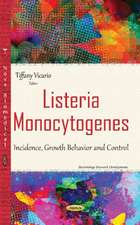The Prokaryotes: Deltaproteobacteria and Epsilonproteobacteria
Eugene Rosenberg Editat de Edward F. DeLong, Stephen Lory, Erko Stackebrandt, Fabiano Thompsonen Limba Engleză Hardback – 29 sep 2014
Different from other resources, this new Springer product includes not only taxonomy, but also prokaryotic biology and technology of taxa in a broad context. Technological aspects highlight the usefulness of prokaryotes in processes and products, including biocontrol agents and as genetics tools.
The content of the expanded fourth edition is divided into two parts: Part 1 contains review chapters dealing with the most important general concepts in molecular, applied and general prokaryote biology; Part 2 describes the known properties of specific taxonomic groups.
Two completely new sections have been added to Part 1: bacterial communities and human bacteriology. The bacterial communities section reflects the growing realization that studies on pure cultures of bacteria have led to an incomplete picture of the microbial world for two fundamental reasons: the vast majority of bacteria in soil, water and associated with biological tissues are currently not culturable, and that an understanding of microbial ecology requires knowledge on how different bacterial species interact with each other in their natural environment. The new section on human microbiology deals with bacteria associated with healthy humans and bacterial pathogenesis. Each of the major human diseases caused by bacteria is reviewed, from identifying the pathogens by classical clinical and non-culturing techniques to the biochemical mechanisms of the disease process.
The 4th edition of The Prokaryotes is the most complete resource on the biology of prokaryotes.
The following volumes are published consecutively within the 4th Edition:
Prokaryotic Biology and Symbiotic Associations
Prokaryotic Communities and Ecophysiology
Prokaryotic Physiology and Biochemistry
Applied Bacteriology and Biotechnology
Human Microbiology
Actinobacteria
Firmicutes
Alphaproteobacteria and Betaproteobacteria
Gammaproteobacteria
Deltaproteobacteria and Epsilonproteobacteria
Other Major Lineages of Bacteria and the Archaea
| Toate formatele și edițiile | Preț | Express |
|---|---|---|
| Hardback (11) | 2590.82 lei 38-44 zile | |
| Springer Berlin, Heidelberg – 4 feb 2013 | 2590.82 lei 38-44 zile | |
| Springer Berlin, Heidelberg – 2013 | 2608.20 lei 38-44 zile | |
| Springer Berlin, Heidelberg – 19 feb 2013 | 2612.21 lei 38-44 zile | |
| Springer Berlin, Heidelberg – 2 ian 2013 | 2621.58 lei 38-44 zile | |
| Springer Berlin, Heidelberg – 31 ian 2013 | 2626.88 lei 38-44 zile | |
| Springer Berlin, Heidelberg – 29 sep 2014 | 3353.51 lei 38-44 zile | |
| Springer Berlin, Heidelberg – oct 2014 | 3649.63 lei 38-44 zile | |
| Springer Berlin, Heidelberg – 13 oct 2014 | 3909.65 lei 38-44 zile | |
| Springer Berlin, Heidelberg – 17 noi 2014 | 3980.48 lei 38-44 zile | |
| Springer Berlin, Heidelberg – 29 oct 2014 | 3988.48 lei 38-44 zile | |
| Springer Berlin, Heidelberg – 18 noi 2014 | 4797.06 lei 38-44 zile |
Preț: 3353.51 lei
Preț vechi: 4412.52 lei
-24% Nou
Puncte Express: 5030
Preț estimativ în valută:
641.68€ • 671.77$ • 530.96£
641.68€ • 671.77$ • 530.96£
Carte tipărită la comandă
Livrare economică 02-08 aprilie
Preluare comenzi: 021 569.72.76
Specificații
ISBN-13: 9783642390432
ISBN-10: 3642390439
Pagini: 414
Ilustrații: XIX, 415 p. 111 illus., 66 illus. in color.
Dimensiuni: 210 x 279 x 30 mm
Greutate: 1.25 kg
Ediția:4th ed. 2014
Editura: Springer Berlin, Heidelberg
Colecția Springer
Locul publicării:Berlin, Heidelberg, Germany
ISBN-10: 3642390439
Pagini: 414
Ilustrații: XIX, 415 p. 111 illus., 66 illus. in color.
Dimensiuni: 210 x 279 x 30 mm
Greutate: 1.25 kg
Ediția:4th ed. 2014
Editura: Springer Berlin, Heidelberg
Colecția Springer
Locul publicării:Berlin, Heidelberg, Germany
Public țintă
ResearchCuprins
Section: Deltaproteobacteria: Bacteriovoracaceae.- Bdellovibrio and Like Organisms.- Cystobacteraceae.- Desulfarculaceae.- Desulfobacteraceae.- Desulfobulbaceae.- Desulfohalobiaceae.- Desulfomicrobiaceae.- Desulfonatronaceae.- Desulfovibrionaceae.- Desulfurellaceae.- Desulfuromonadaceae.- Geobacteraceae.- Haliangiaceae.- Kofleriaceae.- Myxococcaceae.- Nannocystaceae.- Nitrospinaceae.- Phaselicystidaceae.- Polyangiaceae.- Syntrophobacteraceae.- Syntrophaceae.- Syntrophorhabdaceae.- Section: Epsilonproteobacteria: Campylobacteraceae.- Helicobacteraceae.- Nautiliaceae (family): Caminibacter, Lebetimonas, and Nautilia (genera).- Section: Zetabacteria: Mariprofundaceae.
Notă biografică
Eugene Rosenberg, Professor of Microbiology at Tel Aviv University, Israel; Edward F. DeLong, Professor at Department of Civil and Environmental Engineering & Department of Biological Engineering, Massachusetts Institute of Technology, Cambridge, MA, USA; Fabiano Thompson, Professor at Center of Health Sciences, Federal University of Rio de Janeiro, Brazil Stephen Lory, Professor at Department of Microbiology and Molecular Genetics, Harvard Medical School, Boston, MA, USA Erko Stackebrandt, Director of the German Collection of Microorganisms and Cell Cultures GmbH, Braunschweig, Germany;
Caracteristici
The most complete resource on the biology of prokaryotes
Represents molecular, applied and general prokaryotic biology, bacterial communities, and human bacteriology
Covers all taxonomic diversity using the family level to delineate chapters
Includes supplementary material: sn.pub/extras
Represents molecular, applied and general prokaryotic biology, bacterial communities, and human bacteriology
Covers all taxonomic diversity using the family level to delineate chapters
Includes supplementary material: sn.pub/extras
Recenzii
From the book reviews:
“This book … edited and written by great scientists covers essential contributions on different types of prokaryotic communities as well as on the prokaryotic functions in different environments. … This volume, as well as the whole series, should be available in every large scientific library.” (Ioan I. Ardelean, Bulletin of Micro and Nanoelectrotechnologies, Vol. 5 (3-4), December, 2014)
“This book … edited and written by great scientists covers essential contributions on different types of prokaryotic communities as well as on the prokaryotic functions in different environments. … This volume, as well as the whole series, should be available in every large scientific library.” (Ioan I. Ardelean, Bulletin of Micro and Nanoelectrotechnologies, Vol. 5 (3-4), December, 2014)














